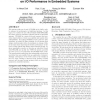Free Online Productivity Tools
i2Speak
i2Symbol
i2OCR
iTex2Img
iWeb2Print
iWeb2Shot
i2Type
iPdf2Split
iPdf2Merge
i2Bopomofo
i2Arabic
i2Style
i2Image
i2PDF
iLatex2Rtf
Sci2ools
SAC
2009
ACM
2009
ACM
Impact of NVRAM write cache for file system metadata on I/O performance in embedded systems
File systems make use of part of DRAM as the buffer cache to enhance its performance in traditional systems. In this paper, we consider the use of Non-Volatile RAM (NVRAM) as a write cache for metadata of the file system in embedded systems. NVRAM is a state-of-the-art memory that provides characteristics of both non-volatility and random byte addressability. By making NVRAM a write cache for dirty metadata, we retain the same integrity of a file system that always synchronously writes its metadata to storage, while at the same time improving file system performance to the level of a file system that always writes asynchronously. To show quantitative results, we develop an embedded board with NVRAM and modify the VFAT file system provided in Linux 2.6.21 to accommodate the NVRAM write cache. The experimental results show that substantial reductions in execution time are possible from an application viewpoint. Another consequence of the write cache is its benefits at the FTL lay...
| Added | 19 May 2010 |
| Updated | 19 May 2010 |
| Type | Conference |
| Year | 2009 |
| Where | SAC |
| Authors | In Hwan Doh, Hyo J. Lee, Young Je Moon, Eunsam Kim, Jongmoo Choi, Donghee Lee, Sam H. Noh |
Comments (0)

